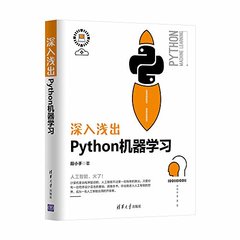Network Automation with Go: Learn how to automate network operations and build applications using the Go programming language
暫譯: 使用 Go 進行網路自動化:學習如何自動化網路操作並使用 Go 程式語言構建應用程式
Leiva, Nicolas, Kashin, Michael
- 出版商: Packt Publishing
- 出版日期: 2023-01-05
- 售價: $1,800
- 貴賓價: 9.5 折 $1,710
- 語言: 英文
- 頁數: 442
- 裝訂: Quality Paper - also called trade paper
- ISBN: 1800560923
- ISBN-13: 9781800560925
-
相關分類:
Go 程式語言、程式語言
立即出貨 (庫存=1)
買這商品的人也買了...
-
 Fuzzing: Brute Force Vulnerability Discovery (Paperback)
Fuzzing: Brute Force Vulnerability Discovery (Paperback)$2,390$2,271 -
 $327深入淺出 Python 機器學習
$327深入淺出 Python 機器學習 -
 RISC-V 架構與嵌入式開發快速入門
RISC-V 架構與嵌入式開發快速入門$474$450 -
 Deep learning 深度學習必讀 - Keras 大神帶你用 Python 實作 (Deep Learning with Python)
Deep learning 深度學習必讀 - Keras 大神帶你用 Python 實作 (Deep Learning with Python)$1,000$790 -
 黑客之道 : 漏洞發掘的藝術, 2/e (Hacking: The Art of Exploitation, 2/e)
黑客之道 : 漏洞發掘的藝術, 2/e (Hacking: The Art of Exploitation, 2/e)$714$678 -
 $602MongoDB 進階與實戰:微服務整合、性能優化、架構管理
$602MongoDB 進階與實戰:微服務整合、性能優化、架構管理 -
 Rootkit 和 Bootkit:現代惡意軟件逆向分析和下一代威脅
Rootkit 和 Bootkit:現代惡意軟件逆向分析和下一代威脅$774$735 -
 物聯網時代的 15堂資安基礎必修課
物聯網時代的 15堂資安基礎必修課$620$434 -
 EN 帶你入門 5G 核心網路(iThome鐵人賽系列書)【軟精裝】
EN 帶你入門 5G 核心網路(iThome鐵人賽系列書)【軟精裝】$760$380 -
 Flutter 跨平臺開發實戰
Flutter 跨平臺開發實戰$414$393 -
 x86 匯編與逆向工程 軟件破解與防護的藝術
x86 匯編與逆向工程 軟件破解與防護的藝術$594$564 -
 $611硬件設備安全攻防實戰
$611硬件設備安全攻防實戰
相關主題
商品描述
Understand the world of modern network automation with Go and deepen your knowledge with insights from 10+ experts who have real-world hands-on experience with network automation and/or are using Go for network-related tasks
Key Features
- A comprehensive guide to the world of modern network automation
- Use Go to build anything from repetitive task automation to complex distributed systems
- Over 30 practical, ready-to-use sample programs
Book Description
Go's built-in first-class concurrency mechanisms make it an ideal choice for long-lived low-bandwidth I/O operations, which are typical requirements of network automation and network operations applications.
This book provides a quick overview of Go and hands-on examples within it to help you become proficient with Go for network automation. It's a practical guide that will teach you how to automate common network operations and build systems using Go.
The first part takes you through a general overview, use cases, strengths, and inherent weaknesses of Go to prepare you for a deeper dive into network automation, which is heavily reliant on understanding this programming language. You'll explore the common network automation areas and challenges, what language features you can use in each of those areas, and the common software tools and packages. To help deepen your understanding, you'll also work through real-world network automation problems and apply hands-on solutions to them.
By the end of this book, you'll be well-versed with Go and have a solid grasp on network automation.
What you will learn
- Understand Go programming language basics via network-related examples
- Find out what features make Go a powerful alternative for network automation
- Explore network automation goals, benefits, and common use cases
- Discover how to interact with network devices using a variety of technologies
- Integrate Go programs into an automation framework
- Take advantage of the OpenConfig ecosystem with Go
- Build distributed and scalable systems for network observability
Who this book is for
This book is for all network engineers, administrators, and other network practitioners looking to understand what network automation is and how the Go programming language can help develop network automation solutions. As the first part of the book offers a comprehensive overview of Go's main features, this book is suitable for beginners with a solid grasp on programming basics.
商品描述(中文翻譯)
了解現代網路自動化的世界,使用 Go 語言並深入了解來自 10 位以上擁有實際網路自動化經驗的專家的見解,這些專家在網路相關任務中使用 Go。
主要特色
- 現代網路自動化世界的全面指南
- 使用 Go 建立從重複任務自動化到複雜分散式系統的任何應用
- 超過 30 個實用的即用範例程式
書籍描述
Go 語言內建的第一級併發機制使其成為長期低帶寬 I/O 操作的理想選擇,這是網路自動化和網路操作應用的典型需求。
本書提供 Go 語言的快速概述及其中的實作範例,幫助您熟練掌握 Go 語言在網路自動化中的應用。這是一本實用指南,將教您如何自動化常見的網路操作並使用 Go 建立系統。
第一部分將帶您了解 Go 的一般概述、使用案例、優勢及固有的弱點,為深入探討網路自動化做好準備,因為網路自動化在很大程度上依賴於對這種程式語言的理解。您將探索常見的網路自動化領域和挑戰,了解在這些領域中可以使用的語言特性,以及常見的軟體工具和套件。為了加深您的理解,您還將處理實際的網路自動化問題並應用實作解決方案。
在本書結束時,您將熟悉 Go 語言並對網路自動化有堅實的掌握。
您將學到的內容
- 通過與網路相關的範例了解 Go 程式語言的基本概念
- 發現使 Go 成為網路自動化強大替代方案的特性
- 探索網路自動化的目標、好處和常見使用案例
- 瞭解如何使用各種技術與網路設備互動
- 將 Go 程式整合到自動化框架中
- 利用 OpenConfig 生態系統與 Go
- 建立可分散和可擴展的網路可觀察性系統
本書適合對象
本書適合所有網路工程師、管理員及其他網路從業人員,旨在幫助他們了解什麼是網路自動化,以及 Go 程式語言如何幫助開發網路自動化解決方案。由於本書的第一部分提供了 Go 的主要特性全面概述,因此適合對程式設計基礎有堅實掌握的初學者。
目錄大綱
1. Introduction
2. Go Basics
3. Getting Started with Go
4. Networking (TCP/IP) with Go
5. Network Automation
6. Configuration Management
7. Automation Frameworks
8. Network APIs
9. OpenConfig
10. Network Monitoring
11. Expert Insights
12. Appendix: Building a Testing Environment
目錄大綱(中文翻譯)
1. Introduction
2. Go Basics
3. Getting Started with Go
4. Networking (TCP/IP) with Go
5. Network Automation
6. Configuration Management
7. Automation Frameworks
8. Network APIs
9. OpenConfig
10. Network Monitoring
11. Expert Insights
12. Appendix: Building a Testing Environment



















